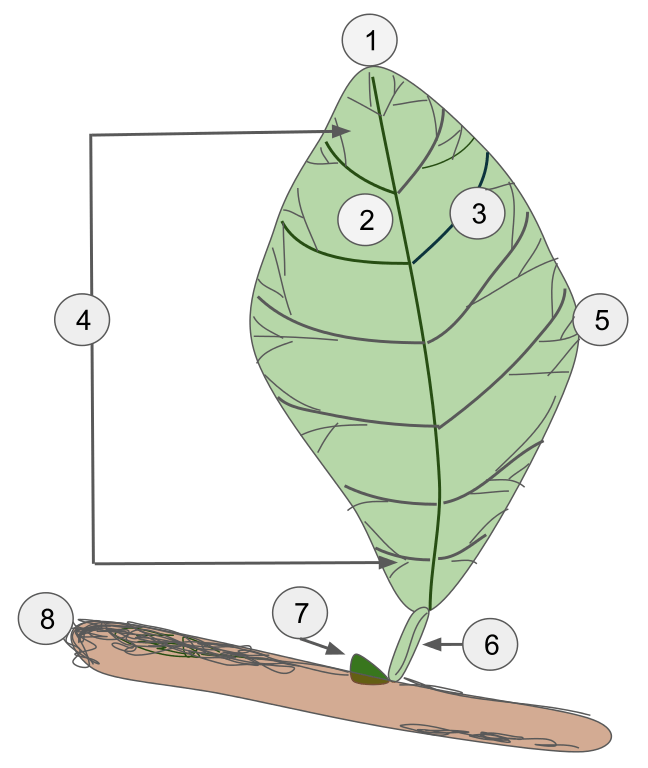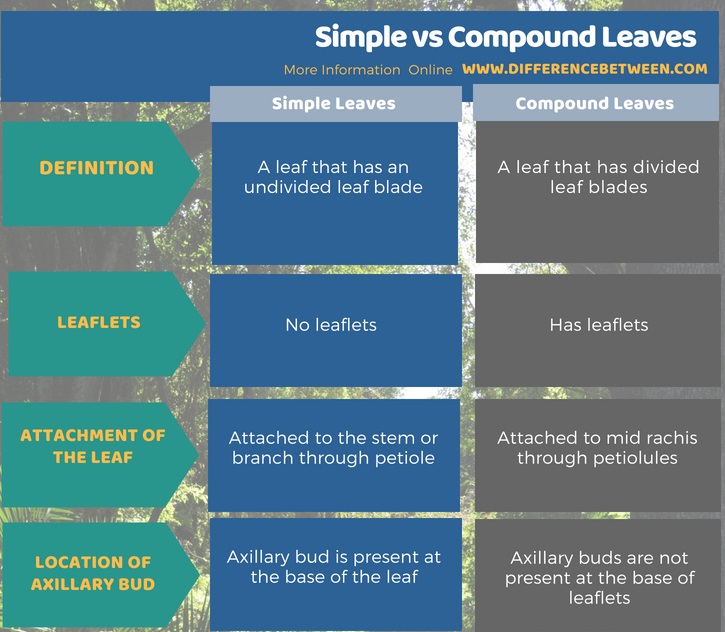The key difference between simple and compound leaves is that the leaf blade of the simple leave is undivided while the leaf blade of a compound leaf has several leaflets.
Leaf is the most important photosynthetic structure in green plants. Furthermore, characteristics of the leaf are useful in identification of plant genera and species. According to the leaf blade or lamina, there are two main types of leaves as simple leaves and compound leaves.
CONTENT
1. Overview and Key Difference
2. What are Simple Leaves
3. What are Compound Leaves
4. Similarities Between Simple and Compound Leaves
5. Side by Side Comparison – Simple vs Compound Leaves in Tabular Form
6. Summary
What are Simple Leaves?
Simple leaf is a leaf that has an undivided leaf blade. Simple leaves generally have only one flattened leaf blade that is directly connected to the stem or branch of the plant. Most plants have simple leaves with petioles or without petioles. These leaves can vary according to their shape. Though simple leaves are generally larger than the leaflets of many compound leaves, there can be some exceptions. Therefore, the ideal way to determine whether the leaf is simple or compound is by the observation of an axillary bud near the petiole and near the leaflets.

Figure 01: Simple Leaf (1. Apex 2. Midvein/Primary vein 3. Secondary vein. 4. Lamina. 5. Leaf margin 6. Petiole 7. Bud 8. Stem)
If there is an axillary bud near the axil, then it is a simple leaf. If there is no axillary bud near the base of leaflets, it is a compound leaf. Mango and Guava are two plant species which have simple leaves.
What are Compound Leaves?
A compound leaf is a plant leaf that has a leaf blade that is divided into leaflets. These leaves are composed of many leaflets, which are attached to the elongated petiole or the rachis. Although leaflets can be confused with simple leaves, they can be differentiated by observing the placement of axillary buds. Leaflets of a compound leaf do not contain axillary bud near their bases.

Figure 02: Compound Leaves
Having compound leaves is advantageous to plants in many ways. According to scientific findings, the presence of these leaves reduces water loss in arid seasons. Moreover, trees can grow quickly by using the compound leaves as branches. Thus, these types of leaves are especially present in tropical and early-successional species. According to the arrangement of leaflets, there are two types of compound leaves: pinnate compound leaves and palmate compound leaves. Rose, Coriander, Neem, and Moringa are several plant species which bear compound leaves.
What are the Similarities Between Simple and Compound Leaves?
- Both have leaf blades.
- They are connected to the plant stem by the petiole.
- Both are photosynthetic.
What is the Difference Between Simple and Compound Leaves?
Simple leaves have an undivided leaf blade and there is an axillary bud at the base of the leaf. However, compound leaves have divided leaves. Thus, a compound leaf has more leaflets than a simple leaf. Furthermore, there is no axillary bud present at the base of each leaflet. In addition, simple leaves are attached to the stem or branch through petiole while leaflets of compound leaves are attached to mid rachis through petiolules.

Summary – Simple vs Compound Leaves
Overall, simple leaves and compound leaves are two types of plant leaves categorized based on the leaf blades. The key difference between simple leaves and compound leaves is that simple leaves have undivided leaf blade while compound leaves have divided leaf blades.
Reference:
1.“Simple and Compound Leaves.” Biology for Everybody, Available here.
Image Courtesy:
1. “Leaf diagram” By Awakening Conscience – Own work (CC BY-SA 4.0) via Commons Wikimedia
2. “Rosebush Leaves” (Public Domain) via PublicDomainPictures
ncG1vNJzZmivp6x7pbXFn5yrnZ6YsqOx07CcnqZemLyue8OinZ%2Bdopq7pLGMm5ytr5Wau26%2FyKanpZ1dlruledWsZJynnaW8trrDZqOemaaawHA%3D